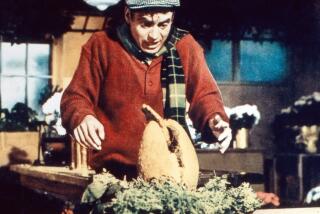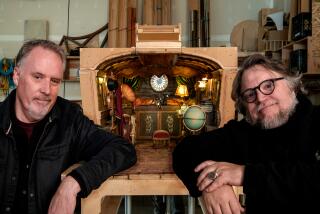Film Maker Norman McLaren Dies at 72
- Share via
Norman McLaren, whose direct drawings on celluloid prompted Pablo Picasso to exclaim that there was “something new in the art of drawing” and who had won nearly every major film award the industry has to offer, died Tuesday of a heart attack.
The Scotland-born McLaren, who had lived in Canada for more than 40 years, was 72 and died in a hospital near Montreal.
Considered among the world’s most innovative film makers, McLaren at his death had made more than 50 of the short pictures that became his signature in a career that spanned four decades and brought him kudos that ranged from Hollywood’s Oscar to Cannes’ Palme D’Or.
His 10-minute vignettes brought him not only praise from around the world but total freedom in his adopted homeland, where he was subsidized by the government and where he also was a founding member of Canada’s National Film Board.
Noted Contribution
Probably McLaren’s most noted contribution to film history was his technique of drawing directly on film. He would create minor works of art without a camera.
Over the years, he used slow motion, regular-speed photography and special effects that transformed dancers and others into abstract patterns.
Many times his work did not involve people at all but were images scratched onto film that had lines and stark colors moving crazily in a single frame. But although many were made without people, most had a moral for humankind.
In 1952, he made “Neighbors,” his most famous, if not greatest, picture. It was a microscopic examination of the relationship between two men. It made use of two actors and a variety of techniques to depict the painful and predictable battle that raged when a single flower chanced to bloom on their common property line.
Classic Example
The eight-minute film ends with the destruction of the robot-like men, their homes and the flower and is considered a classic example of human aggression.
“If all my films were to be destroyed except one,” McLaren said in a Times interview in 1981, “I would want that one to be ‘Neighbors’ because I feel it has a permanent message about human nature.”
McLaren had a sharp sense of humor that extended into his own work.
Asked why he preferred the short film to the extravaganza, he replied that “smallness was financially more comfortable.”
“I was born in Scotland, you know,” he said, adding that “the less money there is, the more imagination there has to be.”
He was born in the city of Stirling where he began making amateur films while still in his teens and a student at the Glasgow School of Art. He made his first animated picture when he was only 21 and beginning to dream of using cinema to unite music, movement and color.
Borrowed Print
He and a friend borrowed a worn-out 35-millimeter print from a projectionist, scraped the celluloid clean of emulsion and then repainted it.
“We made not so much a film, just footage,” McLaren said years later.
He continued to explore the abstract side of film and entered two of his short pictures in a Glasgow amateur film festival. There they were seen by John Grierson, who became his mentor and who invited him to join Britain’s legendary General Post Office film unit in London.
There he began making the war documentaries that made the General Post Office famous, but McLaren wearied of the structured environment and immigrated to Canada in 1941. He became a Canadian citizen in 1952.
During the 1960s he began to experiment with a a process that produced successfully lighter impressions than previous printings. Called “step printing,” McLaren used it to full advantage in “Pas de Deux,” a 1967 piece of diminutiveness that takes two brightly clad dancers from brightly lit scenes into evolving abstract patterns derived from their own movements.
Asked once to explain his penchant for brevity in his work, the lifelong bachelor remembered that he once served on a film festival jury and found himself “classifying each entry ‘.T.L.--M.T.L.--or V.M.T.L.’ ”
That stood for “too long, much too long, very much too long.”
“I don’t want to risk that. To me the best movies are brief, concise and without a wasted moment,” he explained.
More to Read
Only good movies
Get the Indie Focus newsletter, Mark Olsen's weekly guide to the world of cinema.
You may occasionally receive promotional content from the Los Angeles Times.









